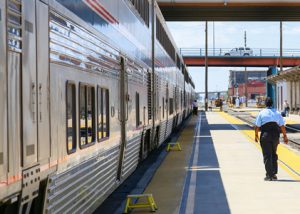[breadcrumb]
How Can a Railroad Conductor and Yardmaster Get Mesothelioma by Occupational Exposure to Asbestos?
Railroad conductors and yardmasters coordinate activities of the train crew and workers engaged in railroad traffic operations like the makeup or breakup of trains.
Asbestos was used in construction materials that were used to build trains, as well as in locomotive parts, so conductors and yardmasters could have breathed in asbestos fibers as they worked.
Common job duties of conductors and yardmasters include:
- Review train schedules and switch orders
- Inspect cars for proper operating abilities
- Make announcements to passengers
- Oversee loading and unloading of cargo
- Oversee and coordinate activities of workers in the rail yard
- Ensure trains are carrying the proper materials
- Remove defective train cars for repairs
- Switch train traffic
Locations in the United States for the Highest Employment Rates for Railroad Conductors and Yardmasters
According to the United States Bureau of Labor Statistics, there are currently 42,360 railroad conductors and yardmasters currently employed in the United States. States with the highest employment rates for railroad conductors and yardmasters include:
- New York
- Texas
- Pennsylvania
- Illinois
- Ohio
Similar Occupations as Railroad Conductors and Yardmasters
Similar occupations as railroad conductors and yardmasters include:
- Bus drivers
- Delivery truck drivers and driver/sales workers
- Hand laborers and material movers
- Heavy and tractor-trailer truck drivers
- Material moving machine operators
- Pilots
- Subway and streetcar operators
- Water transportation workers
Lawsuits and Settlements Involving Railroad Workers and Mesothelioma
There have been a number of cases brought by railroad workers or their families due to asbestos exposure. Six former railroad workers from Norfolk & Western Railway Co. sued the company after they developed asbestosis form working with asbestos insulation. The jury found the company negligent and awarded $4.9 million, which was split between the former railroad workers based on the duration and severity of their exposure.
In 1984, the widow of a railroad worker received a verdict of $235,000 against Chesapeake and Ohio Railway Company. Her husband died from lung difficulties caused by asbestos exposure that occurred when he removed asbestos-containing insulation from pipes and equipment.
Most railroad workers do not have access to the workers’ compensation system. Instead, they must file a claim through the Federal Employers’ Liability Act and establish that their employer’s negligence caused their accident. In 1997, a pipefitter for Metro-North Commuter Railroad Co. who was exposed to asbestos on a daily basis as he removed asbestos insulation from pipes filed a claim of this nature. He brought a suit for emotional distress and future medical checkups after learning about asbestos awareness. He was awarded $34,200 for his claim.
Studies Related to Asbestos and Railroad Conductors and Yardmasters
Numerous studies have discussed the risks of railroad workers and their possible exposure to asbestos. One study found that lung cancer cases were more than three times more likely to arise among operating railroad workers like conductors than nonoperating workers. A study conducted on Belgian railroad workers that was published in 2015 found that railroad workers were more than three times more likely to die of mesothelioma compared to the general population. The study entitled “Past exposure to asbestos among active railroad workers” compared the health risks of railroad workers who worked on steam trains before they were upgraded to diesel engines. Researchers found that 21% of the workers who were 50 years old or older had likely exposure to asbestos even though their exposure was usually short in duration.
Types of Asbestos Products Used by Railroad Conductors and Yardmasters
Railroad conductors and yardmasters could have come into contact with asbestos products that were used for various purposes. For example, asbestos was often included in locomotive parts like brake pads, brake linings and clutches that conductors may have inspected during the course of their job.
They could have also come into contact with asbestos insulation, one of the most popular items that used asbestos before the 1980s. Asbestos insulation was included in or around the engine, boilers, boxcars, electrical panels, pipe covering and the body of a train.
Asbestos was also included in a variety of construction materials railroad conductors and yardmasters worked around, such as plaster, cement, sealants and wallboard.
Manufacturers of Products Used by Railroad Conductors and Yardmasters
Railroad companies often purchased asbestos products while other companies manufactured asbestos products that railroad conductors and yardmasters may have been exposed to such as:
- Aberdeen
- Amtrak
- P. Green
- Armstrong Cork.
- Asbestos Manufacturing Co.
- Asbestos Textile Co.
- Bendix
- Birmingham Southern Railroad Company
- BNSF Railway Co.
- Carolina & Western Railway Co., Inc.
- CertainTeed Products
- Celotex
- Chesapeake and Ohio Railway Company
- Conrail
- CSX Transportation
- Eagle-Picher
- Elgin, Joliet & Eastern Railroad Co.
- Eternit
- Fibreboard
- Georgia Pacific
- Gatke Corp.
- Geness & Wyoming Inc.
- Harbiston-Walker
- Illinois Central Industries, Inc.
- Iowa Interstate Railroad, Ltd.
- Johns Manville
- Johnson’s Company
- Kansas City Southern Railway Company
- Keasbey & Mattison’s Bell Asbestos Mines
- Metro-North Commuter Railroad Co.
- National Gypsum
- Norfolk and Western
- Philip Carey Manufacturing Corp.
- Raybestos-Manhattan
- Ruberoid
- Seminole Gulf Railway LP, Transtar Inc.
- Thermoid
- The Flintkote Co.
- Vermont Asbestos Corp.

